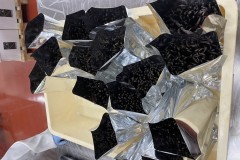Our Vanilla FAQ
AN MVC GUIDE TO PREPARING, PACKING, AND STORING VANILLA FOR EXCELLENCE
Glass or plastic jars are the best methods to keep vanilla beans stored for long periods, good dry and screwed with a plastic cap. Vacuum packing carries a higher mold risk or just flavor distortion if beans are bunched too tightly together suffocated. If vacuum packing is used, it should be in as small quantities as possible per pack, and given space from each other, not bunched too tightly
4 tons of triage and preparation for our vanilla beans in Madagascar takes us for example 3 days in crews of 5 people per ground manager watching in order to triage and pack. Cash and security we usually use in the far interior to procure the green beans at the start of the green in exchange for beans that we then take to our facilities in SAVA, via a boat moored in Antalaha, and several SUV’s all with crews. July 15 is the start of the green season in Madagascar while Oct 15 is the start of the export season, yet stocks are sold and used all year round so proper keeping is vital to optimize the love, length, and lives of the beans.
To give an idea of why breathing and isolation as well as insulation makes the vanilla taste good and keep that way, consider the complexity yet importance of the preparation process. – In the morning we dry in the sun, and then roll up to cool off with staggered positions on blanket rolls, alternating between the sun and the shade and wrap. As afternoon humidity descends, we keep the vanilla covered, and the next morning after a cool dry night storage, we start the process again. The result of the real traditional bourbon method and curing is amazing – at around 28-30% humidity, vanilla has a long life and the most delicious smell that permeates far into the future of its existence as a whole bean, and into the recipes it ultimately arrives as a crucial ingredient.
Overnight, during preparation vanilla is wrapped warm in blankets but in the cool and dark to prevent condensation, under lock and key. When it is packed, it is grouped and bundled by size, quickly manually sorted by our staff in long rows of counters, and after counted it is raffia wrapped with roasted and dried raffia (as simple raffia can have humidity in the fibers, making it pliable rather than brittle and dry, which is anithema to the beans.) The beans are placed in paper wax boxes in tiered layers. It is even here imperatively important that beans are given space from each other to breathe, not too tightly congested, or else the natural flavor evolution of the flavor profile will be stifled, and there is increased spoiling, overdrying, or flavor change risk as well.
![]()
If you use a vacuum sealer, have the setting set to 8% for black, or 10% for red, and consider vacuuming the beans in in small quantities with wax paper for storage – We also advise avoiding a Chinese-made machine – as vacuum pressure is very very important, or vanilla oils can run out.
However, for the end user or distributor, glass or plastic dry jars with plastic lids, storing only about 1kg is best – with space to breathe. Up to 5kg per jar. Tins are good too, such as 5kg boxes made of tin. We advise in short to use tin or jars, sealed, in cool dark and dry areas, not in the fridge, and avoid vacuum packs. Although corks are aesthetic if done correctly for retail units, we also advise that tubes of vanilla beans stick carefully to only plastic caps, in case corks are improperly sealed or dried and thus incur and intake humidity. The main consideration above all is the integrity of the flavor and the shielding from humidity. There will be slight evaporation of a few grams of vanilla weight if vacuum packing isn’t used, and a large portion of the end users for vanilla end up with beans vacuum packed in some fashion, but the flavor and the room to breathe will make vanilla far superior in ultimate flavor. There are even beans we store in SAVA that are 5, 8, and 9 years old, that are still just as perfect in smell as they were their harvest years!
Shipping wholesale is done typically with plastic wrap , box cartons, and wrapped with a tarp bag outside. Export documents are included with each shipment as well and around 25kg per box is tuned to Madagascar-optimized logistics and easy shipping via the legal formal channels.
MVC Japan team carefully packing and preparing vanilla with correct conditions as per ISO, SGS, HAACP, and FDA and JFDA protocols and practices
Premium ground Madagascar vanilla powder, for example, which sells and smells amazing and tunes at the biological level to 1.6-1.8% vanillin, is ground from red vanilla beans and their red splits (split pods.) How to choose between red and black vanilla? – There is a marked difference between the flavor profile (not objective superior or inferior quality, but actually subjective taste) of red vanilla and black vanilla, and a difference in the finished scent of the pod and its strength of aroma, the “jump” of the smell from the beans’ exposed particulate matter that transits through air to the human nose.
Red and black vanilla beans also even interact and combine/distill with different alcohols to taste differently in a finished extract. For example the matrix made from red vanilla beans or black vanilla beans (rouge or noire) extracted in rum, vodka, or bourbon make a seriously different palette of 6 distinct tastes.
In fact, the comfortable fair trade living wage is calculated often around $6000 per household, which would mean 4 people working at the average wage in that household. Vanilla farms are started by remote bush farmers not by centralized vanilla companies 95% of the time, and the other 5% of the time negotiations on green vanilla market price still need to be made. Farmers of vanilla simply get as much cash per kg for green as they can, through collective unionized bargaining in groups (collectives) to individual croppers who purvey their vanilla along the Antalaha<>Vohemar road searching for the best price. The fair trade price for vanilla is always less than they actually make for it, and so they profit in fact more than a fair trade price.
The conflict of interest is so glaring here in Madagascar that generally “fair for life” just means suitable working conditions with sanitation and reasonable working hours audited for a few days every couple of years. Vanilla farmers in the countryside generally set the price in equilibrium with the demands of collectors and exporters. The fair for life price is almost always LOWER than the price that is paid per kg to farmers in Madagascar, and so the entire premise of FFL is generally a ruse when it runs its course, as 1% of all days of the year is any of it ever monitored (if even that.) It would not be hard within a day of any single certification of FFL to point out a breach in codes in any vanilla company, anywhere in the world, big and small. FFL is now cynically but correctly curtailed in believability by American consumers (and to a lesser extent, Europeans) who have already waken up to the racket since the mid 2000’s, after the coffee industry invented it to erect monopolies for rich families in central and south America.
Organic vanilla is also largely a dissonant term….All vanilla IS necessarily organic. Unlike other crops, it is not really possible to grow vanilla non-organically, plus pesticides rapidly destroy the natural lifespan and flavor and scent of the bean. Like fair-trade charade, organic labels were mainly initially invented by the coffee industry in Central America to establish monopolies at the exclusion of poorer farmers not able to get the papers for identical (or even inferior) products.
MVC group for example has all of the certification papers, but will be the first to deride how de-synchronized the real ground conditions parity to this practice in some European and American office is. It is not possible to have vanilla that’s not organically grown in Madagascar. The only difference is a paper. “Conventional” vanilla is indeed organic as well, and the problem is more conventional wisdom than conventional growing practices. We only have the organic certification papers in order to signal natural growing further to our customers. Albeit yes it’s also true that the vanilla is organic…but we and many participate in these ceremonial sticker awards as to check the box for multi-input organic products that need every ingredient to be certified like this. Some companies and customers in the global north require every single input to have its own paper organic certification.
Outside of them, a few of the legacy exporters in SAVA do collectively a few hundred tons per annum as well, and have colluded since roughly a few decades ago after Madagascar independence…but these legacy exporter groups are steadily losing market share of old clients, and easily losing market share of newer demands and buyers due to the onset of the internet age, the new generation of children in Madagascar who have ambitions for their own vanilla empires, and to the fragmentation of supply into dozens or even hundreds of exporters during different times of the year.
On the island, there is the sense of the spice that comes from being born literally playing in fields of vanilla vines and seas of sunning vanilla beans…Thus, the intractable factor which cannot be divorced from the island, the ingredient which makes the real best beans, is that the people live and breathe vanilla here, and it is their way of life and art, not an industry, to all these farmers and residents of the vanilla coast.
The Tahitian (Tahitensis) species does not typically ever grow in Madagascar, but excellent crops of this species can be found in the Pacific. For Planifolia species, still to this date, despite decades and surpluses of effort and investment, nobody can match Madagascar’s kaleidoscope of culture, conditions, and curing wisdom…or even taste remotely the same. Try it for yourself.
Also at the end of a boom cycle in global vanilla prices, after a crash, which tends to happen roughly once a decade.
We are not allowed to export green vanilla vines to you without an expensive and extensive regime of authorizations on both sides.
We can train your farm and workforce how to use the bourbon pollination method and monitor quality and cutting time, but this requires a multi-year contract and audits and monitoring as well as pre-planting site surveys.
More moisture looks nice and expands the aroma, at face value, but in the actual food you make brew or bake with it diminishes the impact and strength, as you are literally buying water weight for mere optics and appearances.
Still, the flavor expression is different with vanilla between this range, so it is also down to preference, as much as PR.
It is not safe nor stable to have vanilla over around 35% moisture. 30% is a better cap before you should be skeptical on whether you are being scammed.























